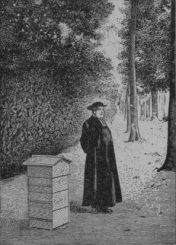
Warré plans
Warré methods
Warré modifications
Warré precursors
Groups / Fora
Google
e-group
Biobees.com
forum
Abbé Warré's book
Beekeeping for All:
Alberta Warré Experiment
Location of apiary: 4200 ft (1281 m) near Calgary, Alberta, Canada
Meteorological data: Calgary, Springbank Airport
51 10 N, 114 36 W,
3937 feet (1200 meters) above sea level.
| Monthly Averages | Jan | Feb | Mar | Apr | May | Jun | Jul | Aug | Sep | Oct | Nov | Dec |
| Temperature | -7 | -9 | -1 | 2 | 7 | 10 | 13 | 14 | 9 | 3 | -2 | -7 |
| Maximum Temperature | 0 | -2 | 5 | 10 | 15 | 17 | 21 | 22 | 17 | 11 | 5 | -1 |
| Minimum Temperature | -12 | -15 | -6 | -3 | 0 | 4 | 6 | 7 | 2 | -3 | -7 | -12 |
| Rain Days | 0 | 0 | 0 | 1 | 4 | 8 | 5 | 4 | 3 | 1 | 0 | 0 |
| Snow Days | 3 | 3 | 4 | 4 | 1 | 0 | 0 | 0 | 0 | 2 | 2 | 2 |
Low humidity most of year. The temperature can often drop to -30 to -35C in winter. In January 2009 it ranged from -37C to +15C.
Hive construction
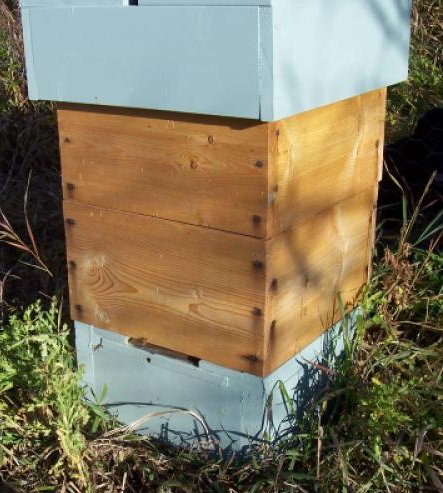
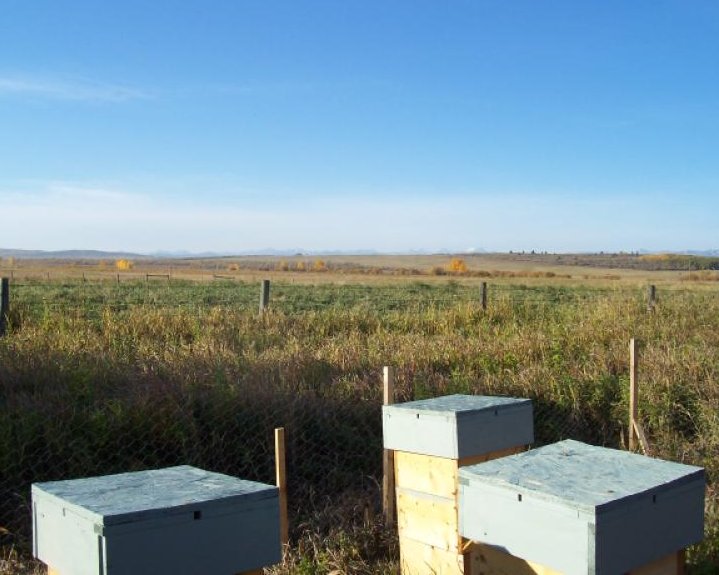
Base or 'sump'
Empty box, 150 mm high, open at bottom, mesh at top (immediately below entrance),
Warré-sized entrance, walls 38 mm thick, open to ground, rests on ground.
Hive-body box (Hausse)
Warré internal footprint, no handles, 38 mm walls.
Quilt ('Kissen', 'Coussin')
Standard Warré specification. Filling: sawdust.
Roof
Flat box, conventional (non-Warré) design with small vent hole on each
side. (similar to http://warre.biobees.com/heaf.htm
). There is no waterproof sheeting on top, just two coats of latex
paint on oriented standard board.
2008-9 Season Management
12 Warrés populated on 4 May 2008. One failed to accept queen. By 5 August, 2 were occupying two boxes, 5 were occupying three boxes, 3 were occupying 4 boxes and 1 was occupying 6 boxes. Two hives had boxes added to the top (supering) during the main flow. Otherwise boxes were nadired (added to bottom below colony) in the normal Warré beekeeping fashion.
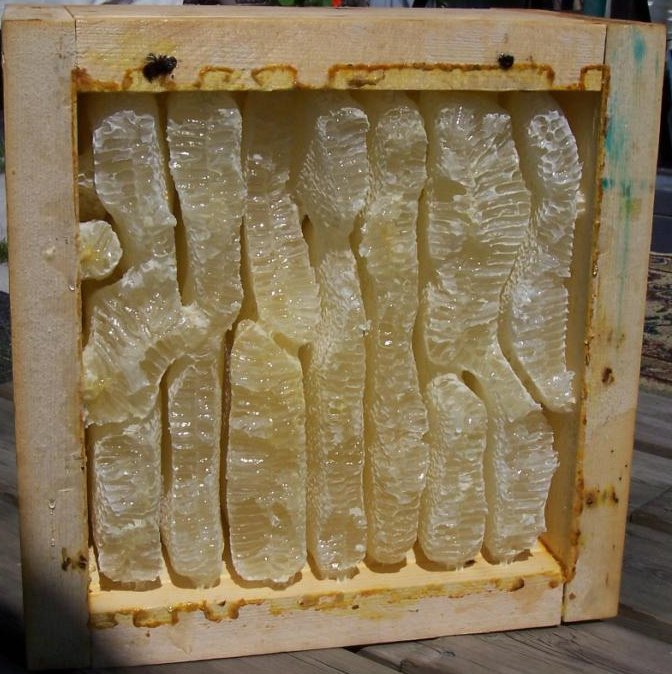
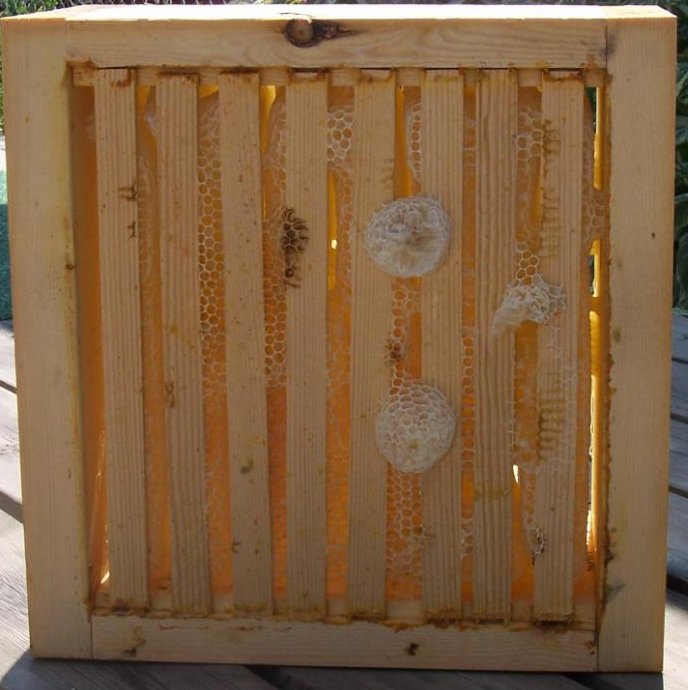
Picture above: harvested box from below (left) and from above (right)
2008 harvest: 11 boxes, circa 130 kg, ~12 kg/hive. Harvested by cutting out comb, mashing with potato masher and draining through cheescloth in a colander overnight.
Sumps: no signs of mildew or rot. Accessible to ants, centipedes and possibly mice. Mesh prevents mouse access to colony.
Wintering: 5 with 2 boxes, 6 with 3. Total: 11 wintered. All hives wrapped above entrance with bitumenised building paper over light packing (1/2 inch fibreboard), but loosely so they could 'breathe'. The building paper extends up under the roof but does not cover the quilt material. Several colonies went into winter with less than 25 kg honey stores, a few even with less than 20 kg.
December: Enough snow to cover the sump, entrance and entire bottom box. If insulation is required, a thin mulch of dried leaves or pine needles casn be added.
Mid-January apiary visit: 10 colonies flying, one dead due to late season queen failure. Quilts checked and found to be bone dry.
15 March: 11/11 still alive but further severe weather and snow preventing flight.
2009 plans
Increasing wall thickness to 46 mm while keeping internal width to 300 mm. Blanking out the corners to create an octagonal brood chamber. No top-bars but instead spales* in each box to stabilise comb. Box height, 250 mm to suit available timber size. (Warré's box height is 210 mm.)
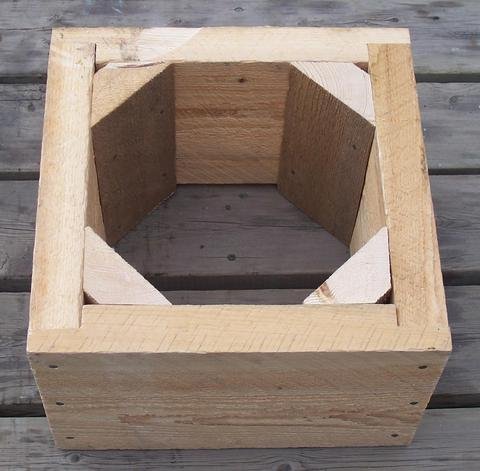
2010-2013
The internal size was increased to 15" x 13" (380-330 mm). Top entrances (1 1/2" x 3/8", 38 x 10 mm ) are provided by means of a feeder left on the whole year. No Warré quilt is used. When not used as a feeder, this formed a condensate trap of water accessible to the bees in the spring. When the warm weather comes, the top entrance is closed and the bottom one enlarged. Average harvests in 2013 were 68 kg.
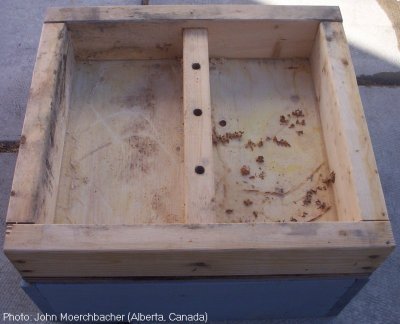
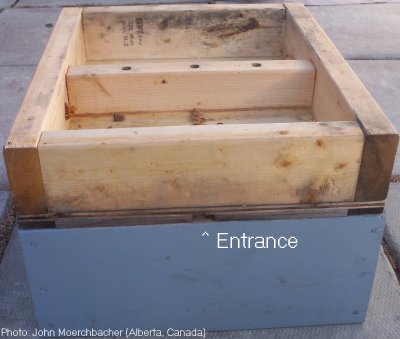 Top views
Top views
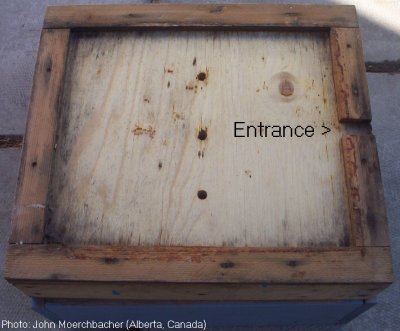 Bottom view
Bottom view
Contact
John Moerschbacher is conducting this experiment and can be contacted at: moersch51 at yahoo dot ca (please reconstitute this anti-spam e-addeess).
* spales are thin sticks and wre pushed through the sides of skeps to support the comb